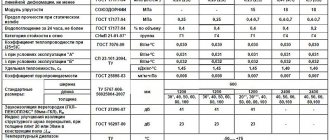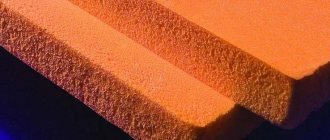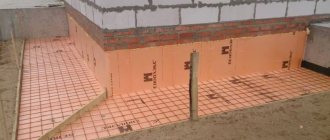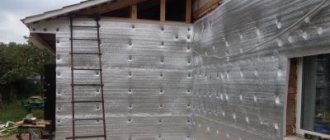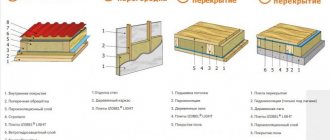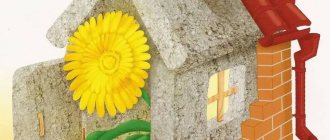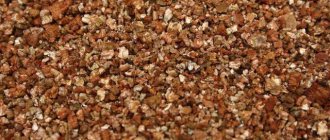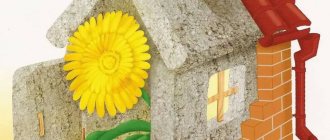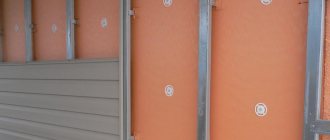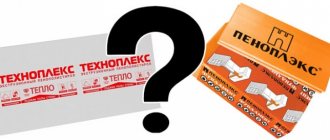In this material: the pros and cons of expanded polystyrene. Simple, detailed and clear. Perhaps this article will change your plans regarding home insulation. Read and comment. At the end of the article there is a reader survey .
Interested in foam plastic? Have you decided to use it to decorate your home? Then now we will tell you what advantages and disadvantages polystyrene foam has.
We will consider mainly using the example of a conventional PSB-S. Let's start with the pros and then move on to the cons of this material. We will tell you absolutely everything, without hiding anything. By the way, according to
What is EPPS?
In everyday life, this material can be found under the name “foam plastic,” but this is fundamentally incorrect. These two materials are significantly different from each other. For example, extruded polystyrene foam (EPS) is one of the most deformation-resistant and durable varieties, and its heat-shielding properties are almost not affected by this.
High-strength EPS is produced on special production lines through chemical extrusion of the original raw material, which is pure polystyrene granules.
Using special equipment, raw materials are converted into foam, from which, in turn, small granules are produced. During the hardening process, these granules are pressed into layers of the required shapes and sizes, after which they can be used not only for insulating houses, but also for other purposes.
It is precisely due to its fine porosity that EPS is an order of magnitude stronger than ordinary polystyrene foam. These granules, pressed under high pressure and at high temperatures, give the material greater strength, hardness and reliability.
The main difference between extruded polystyrene foam and pressed polystyrene is in the characteristics of its granules. They are smaller, which makes this building material more resistant to physical stress. The size of granules of heat-insulating material produced by extrusion does not exceed 0.1 mm, while granules of non-pressed material can reach up to 10 mm.
In foreign interpretation, EPPS may be called XPS. It is produced in several varieties. After the abbreviation “XPS”, the markings of this material contain numbers from 25 to 45, which indicate its density.
The higher the value, the higher the density of the material. Particularly dense extruded material can even be used to insulate asphalt road surfaces, for example, the products ]Penoplex[/anchor].
Now that we have figured out what EPS is, we will discuss in detail all its pros and cons.
Expanded polystyrene production technology
The manufacturing process is a chemical reaction during which a blowing agent and steam are added to polystyrene particles. Under the influence of temperature and additives, polystyrene expands in volume up to 50 times, occupying the entire allotted area of the mold.
Interesting fact! Regulatory documents indicate that the thermal properties of 10 cm thick polystyrene foam are similar in thermal conductivity to the following materials:
| Material | Expanded polystyrene | Reinforced concrete | Solid clay brick | Clay hollow brick | Solid silicate brick | Expanded clay concrete | Tree |
| Thickness | 10 cm | 4.8 m | 1.75 m | 1.45 m | 1.9 m | 0.5 m | 0.35 m |
The main advantages of the material
In fact, polystyrene is the same plastic, only endowed with different qualities. But just because it is somewhat lighter and less dense, it does not cease to be plastic, and therefore it has all the advantages of this material.
To ensure that the owner does not bother with cladding the front side after insulating the building, manufacturers have come up with an excellent solution. They began to produce sandwich panels, in which a sheet of extruded polystyrene foam is initially equipped with a decorative panel made of any material of your choice
One of the main advantages of expanded polystyrene is the lightness of the material , but its other advantages are also no less significant:
- Resistance to fungal infections . As you know, a fungus needs to eat something to survive. But synthetics, like food, are not suitable for him.
- The material does not rot or decompose . Only natural, biological materials are subject to rotting and decomposition. Eps is, initially, a product synthesized from artificial polymers, and therefore there can be no decomposition.
- Compression resistance . EPS, especially high density, can withstand enormous loads.
- No moisture absorption . Anyone knows that a plastic bag does not allow water to pass through. This quality is not alien to polystyrene foam.
- Frost resistance . The material does not freeze through because there is simply no moisture in it. It is airy, but at the same time absolutely “dehydrated”.
- Low degree of thermal conductivity . As already mentioned, this material is literally filled with air, and air is the most intense heat insulator.
Due to the fact that EPS is essentially plastic, it has low vapor permeability, which in many cases can be considered a positive quality. Thus, expanded polystyrene is successfully used to insulate the attic.
Plus, polystyrene is resistant to most chemicals.
A building insulated with EPS is, as it were, enveloped in a layer of air, since polystyrene foam, for all its strength characteristics, is unusually airy
Another significant advantage is that:
- EPS, with its extreme strength, has a very low weight, which reduces the load on the foundation if the material is used to insulate the upper part of the building.
- It is very resistant to temperature changes. Temperature surges hardly expand or contract its structure, as happens with denser substances and materials.
- It is very easy to install, and since it can be easily cut even with a sharp knife, it can be used to form a block or segment of non-standard geometry of the required size with extreme ease.
- Installation work on insulating buildings using EPS can be carried out at temperatures from -50 to +70 degrees Celsius, that is, practically all year round and in any climatic zone.
- It adheres well to other building materials. Even plaster adheres to it perfectly.
And if you add in the durability of the material, you may get the impression that XPS is a panacea for all ills. But, unfortunately, insulation made from polystyrene foam also has a number of disadvantages.
Other foam amenities
- The lightest material for working with it yourself.
- It can be cut with a hacksaw or knife.
- It lends itself to curly cutting and you can make a hole in it if necessary. Most often this is required if windows with cornices or decorative types are insulated
- Polystyrene foam adheres to any surface and is easily subjected to additional processing, such as painting or plastering.
Significant disadvantages of insulation
Despite the fact that the material has much fewer disadvantages than advantages, in some cases they become the key reason for refusing to use it.
As it turns out, plastic not only has advantages, and all the disadvantages of EPS are also related to the fact that it is of “polyethylene nature.”
When insulating frame and wooden houses, it is best to choose special extruded polystyrene foam impregnated with fire-resistant agents. The photo clearly shows that it will be very difficult, if not impossible, to set such material on fire.
The main disadvantages of extruded polystyrene foam are:
- Poor sound insulation . The material is able to slightly muffle sound waves, but it is not able to absorb them completely, nor can it reflect them.
- Sensitivity to ultraviolet radiation . Under direct sunlight, without specially hiding materials, for example, plaster and other finishes that, among other things, serve as protection, the EPS is destroyed.
- Low vapor permeability . In some cases this can be a plus. But not in all of them. Therefore, homes insulated with extruded polystyrene foam require impeccably installed and effective ventilation. Otherwise, condensation will accumulate in the walls, which will contribute to their destruction.
- Low environmental friendliness of the material. No matter how manufacturers of polystyrene foam protect their product, plastic always remains plastic. Even if it is porous, it will still decompose much longer than any non-synthetic substances.
- The high cost of this type of insulation also makes some people think. Moreover, the harder and denser its variety, the more expensive it is.
Separately, I would like to point out that, for obvious reasons, this material is very susceptible to attacks from rodents.
If rodents have access to polystyrene foam, they can travel along the walls in it, gnawing holes in it. Animals use small granular particles to decorate their nests.
If there is open access to the EPS insulation layer, mice and rats make whole labyrinths of passages in it and even make their nests in them.
Therefore, it is advisable to carefully seal the layers of insulation with such finishing materials that rodents will not be able to get through to the coveted layer of polystyrene foam.
But the main disadvantage of this type of material is the low degree of fire resistance. As soon as the edge of the stove catches fire, the flame instantly eats it completely. Moreover, combustion is accompanied by the release of highly toxic substances into the atmosphere - phenols, which can cause no less dangerous harm to the lungs than the high temperature itself.
Ordinary extruded polystyrene foam can catch fire, depending on prevailing third-party factors, at temperatures from 250 to 450 degrees Celsius, which is why it should be used for insulation of wooden buildings and structures with the greatest caution.
In such cases, experts advise purchasing EPS, flavored with special fire-resistant additives during the production process.
1.5 Tendency to shrink
Shrinkage, like moisture absorption, is the main enemy of any insulation. When the material shrinks, cracks appear in the thermal insulation structure, which significantly reduce the overall insulation efficiency.
One of the main problems of polystyrene foam is its tendency to shrink when heated. Deformation manifests itself to a greater extent when the product is heated; therefore, it is better not to use polystyrene foam for thermal insulation of heated floor systems, and when insulating a facade with polystyrene foam, the insulation must be covered with white plaster, which protects from UV rays.
Things are much better with extruded polystyrene foam; the material practically does not shrink under any operating conditions.
Components of polystyrene foam beads
Rules for working with material
Most often, extruded polystyrene foam is used to insulate foundations, floors, walls and ceilings of residential and commercial buildings. For example, for insulating the walls of a loggia/balcony or the walls of a residential apartment from the inside.
But those who decide to use this material to insulate their own building should remember a few rules.
If the wall is sufficiently smooth and rough, the EPS will adhere perfectly to the adhesive mass. But most often, due to the geometry of the walls, it is more advisable to install polystyrene foam slabs using special dowels. This method is also chosen because it is more budget-friendly.
What are EPS boards placed on?
Extruded polystyrene foam slabs are easily attached to a flat and dense vertical surface using special types of glue. It can be Penoplex FASTFIX, TechnoNIKOL or dilutable adhesive mixtures such as Ceresit CT 83.
If you don’t want to bother with glue, or the surface structure does not allow it, you can resort to fasteners such as special dowels. In general, before insulation, it is advisable to level the surface of the walls with at least rough plaster and place the slabs on both of the mentioned fasteners at once - both on glue/cement mortar and on dowels.
The Ceresit CT 83 adhesive mixture, according to the developers, can be used at temperatures from 0 degrees Celsius. It is also claimed that it is very economical and environmentally friendly
Insulation of foundations and floors
In the case of foundations, all external sides are covered with EPS slabs, after which the newly made thermal insulation layer is covered with a layer of waterproofing. Often homeowners decide to insulate even the blind area.
In this case, a layer of concrete is formed over a layer of expanded polystyrene, which, in turn, rests on a bed of sand and gravel mixture.
The concrete floor screed is also erected on top of evenly laid EPS slabs.
EPS is also used as one of the methods for insulating wooden floors. We talked about this in more detail in the next article.
A blind area insulated with polystyrene foam will help protect the upper part of the foundation from freezing. Plus, a layer of such material will also work as an additional water-repellent layer.
Cutting expanded polystyrene boards
Since the density of extruded polystyrene foam is an order of magnitude higher than that of regular polystyrene, a number of small problems arise with this. For example, this type of material can still be cut with a knife, but firstly, the blade must be extremely thin and strong, since a thick blade can cause the slab to discolor and crack.
And secondly, the creaking and grinding noise that will accompany such an “event” will be an order of magnitude higher than in the case of ordinary polystyrene foam. Therefore, before starting the procedure, it is recommended to lubricate the knife blade with machine oil.
Some people use a grinder equipped with the thinnest metal wheel to cut EPS blocks. Cutting, in this case, is efficient, but the whistle is so loud that it is better to put plugs in your ears. Among other things, this method is the most “unclean”. It will leave a huge amount of garbage behind.
If you decide to use a grinder to cut polystyrene foam, we recommend that you familiarize yourself with the rules for using this equipment.
You can easily make a machine or machine for cutting polystyrene foam yourself. To do this, you just need to get some nichrome and a powerful transformer. By connecting the opposite ends of the nichrome wire to the wires coming from the power source, we get a kind of polystyrene foam knife. To make the cut as even as possible, the nichrome wire in the device should be kept taut
The most effective and simplest method is considered to be cutting with hot wire. Take two nails, between which a nichrome wire is stretched. Voltage is applied to the nails through a transformer, the wire becomes hot and the process begins. Using this method, you can cut out the most precise blocks and shapes of a high degree of complexity.
But this method is also the most harmful. As already mentioned, phenol vapors released during the cutting process can cause significant harm to the human body, and therefore, this procedure should be performed in the open air, preferably in a draft or using a special respirator, or even a gas mask.
Few people know, but polystyrene foam makes an excellent formwork for foundations. The material lends itself perfectly to cutting, drilling, etc., and therefore anyone, showing a certain amount of ingenuity and resourcefulness, is able to make a wonderful insulated foundation for their structure
Fire safety measures
When working with extruded polystyrene foam, you must adhere to strict fire safety measures, otherwise extinguishing the fire will be much more difficult than it seems.
That is why, in case work is being done nearby using an open fire, for example, there is a furnace with which bitumen is melted, etc., you should always have a water supply hose, a fire extinguisher, or, at worst, a barrel of water and a bucket at the ready .
It is recommended to do the same when carrying out welding work in close proximity to the EPS. Moreover, it is advised to either shield the material from sparks and scale flying from welding, or pre-moisten nearby polystyrene slabs with water; it is better to do both at the same time. Only in this case will you protect both yourself and your building from fire.
Most fire hazards at construction sites occur precisely because of neglect of safety precautions. If welding work is carried out near work carried out using flammable materials, always expect disaster. To prevent this disaster from happening, you should always keep at least a fire extinguisher on hand.
Scope of application
Expanded polystyrene is one of the few thermal insulators characterized by a wide range of applications. It can be used to create thermal protection for all surfaces of a building: from the foundation to the roof.
Foundation structure
Insulation is used to insulate the outer or inner side of a strip foundation. The ideal option is permanent polystyrene foam formwork.
For these purposes, it is advisable to use extruded EPS, which has a low water absorption rate due to its closed cellular structure. When insulating only the outer side of the foundation, you should choose expanded polystyrene foam.
Fixed polystyrene foam formwork
Foundation insulation
Swedish plate for insulating the foundation USHP
When insulating basement walls and foundation surfaces, it is important not to forget about waterproofing.
Among the new developments that are attracting more and more attention is the Swedish stove. Expanded polystyrene is often used in its construction. USHP (abbreviation for slab) is a monolithic foundation made of slabs, which has an insulating layer. This is a cost-effective and reliable solution for arranging the foundation of a house.
Walls
Expanded polystyrene is used primarily for cladding external walls. If necessary, the material is laid on the internal surfaces of the building. This option is possible due to low vapor permeability, which does not require the installation of a vapor barrier.
An alternative way to insulate walls is to lay polystyrene foam boards in the space between the layers of brickwork.
To calculate the amount of polystyrene foam for insulating walls and foundations, use the online calculator.
When insulating the walls, PPS receive additional benefits, which is expressed in increased sound insulation of the building.
Floors
Most often, expanded polystyrene is used to form a heated floor cake. A layer of insulator is placed on the ceilings, then a heating cable/pipes for the coolant. Fix the system with a layer of screed.
Another application option is insulation of attic floors. Thermal insulation material increases the energy efficiency of the house and reduces the cost of heating the living space.
Roof
Expanded polystyrene is placed in roofing pies of flat and pitched roofs. It protects the attic well from temperature changes and heat loss. Mounted on the ceiling, above the rafters, between and under the rafters.
Conclusions and useful video on the topic
You can learn about the criteria by which extruded polystyrene foam should be selected from the following video:
Considering that almost no one pays attention to the weak sound insulation of insulation, sensitivity to ultraviolet radiation is treated by the fact that the material is always protected by a layer of finishing, and low vapor permeability as a minus is eliminated by the presence of good ventilation, of the total number of shortcomings, only “not environmentally friendly” and the “expensiveness” of the material, but these shortcomings are also easy to refute.
The very concept of “not environmentally friendly” suggests that the material is extremely durable, since over time, especially with proper use, it does not break down into its components. Isn’t this a criterion for considering the “non-environmental friendliness” of a building material as a plus? Well, regarding the high cost of EPS, there is an excellent proverb: “The miser pays twice.” With all the ensuing morals and consequences .
Have you thought about using EPS as insulation and want to clarify a couple of nuances of its use after reading our material? Ask any remaining questions to our experts below this post - we will try to help you.
If you are a professional installer of XPS and want to give useful advice to beginners or supplement the material presented above with valuable comments, write your comments in the block below.
Briefly about the main advantages:
1. Wide range of applications (the ability to insulate walls, ceilings, basements and basements). 2. Durability (more than 30 years with proper use). 3. Low thermal conductivity, providing good thermal insulation. 4. Light weight (starting from 10 kg/m3). 5. Artificial origin, which allows you not to worry about the spread of harmful microorganisms. 6.Attractive, low cost, with good quality.
1.3 Hydrophobicity
The ability to absorb water is an important characteristic of any thermal insulation material.
In high-quality insulation, this property should be minimized, since when moisture accumulates, the insulation is prone to losing its thermal insulation characteristics, increasing weight and, with constant exposure to a humid environment, rotting and destruction.
Extruded polystyrene foam has a closed-cell structure, as a result of which the material has virtually zero moisture absorption. Unless it's defective. Therefore, we recommend buying insulation in Moscow to avoid defects.
When completely immersed in water for 24 hours, extruded polystyrene foam absorbs liquids no more than 0.2% of its volume, while this figure does not actually increase with a longer stay of the material in water - when immersed for 30 days, expanded polystyrene absorbs 0.4% of the volume.
Due to the structural differences in polystyrene foam, this indicator is much worse - in 24 hours the material, when fully immersed, absorbs 2% of the volume, when immersed for 30 days - 4%.
Structure of extruded polystyrene foam
